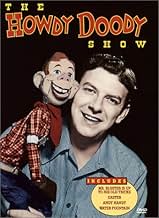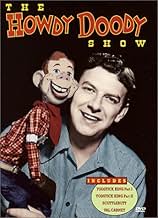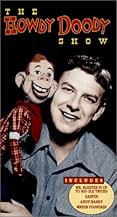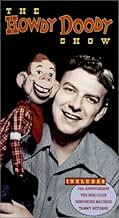La première émission télévisée américaine pour enfants diffusée à l'échelle nationale et un prototype de ce qui a suivi. Buffalo Bob Smith anime l'émission tandis que la marionnette Howdy Do... Tout lireLa première émission télévisée américaine pour enfants diffusée à l'échelle nationale et un prototype de ce qui a suivi. Buffalo Bob Smith anime l'émission tandis que la marionnette Howdy Doody en est la vedette.La première émission télévisée américaine pour enfants diffusée à l'échelle nationale et un prototype de ce qui a suivi. Buffalo Bob Smith anime l'émission tandis que la marionnette Howdy Doody en est la vedette.
- Nommé pour 2 Primetime Emmys
- 1 victoire et 2 nominations au total
Parcourir les épisodes
Avis à la une
Howdy Doody" was the first television show I ever remember watching as a very young kid. I hadn't seen it in about 55 years so, at first, it was kind of shocking to view a few episodes just the other day. A new DVD by Mill Creek Entertainment came out last last year (2008) and contains a number of episodes from 1949-1952 and all of them with pretty good transfers.
The show is not something I could enjoy now as a 60-plus-year-old man, but it was interesting to see the principal characters again. I viewed three of the episodes and, frankly, that was enough. It was fascinating to look back, though. I can't believe how the plugs they did for their sponsors, like Halo Shampoo or Three Muskateeres candy bar, were worked into an audience-participation thing. It's so different from what we've known the last 40 years. Instead of cutting away to a commercial, they plugged the products as part of the show.
Speaking of participation, I had also forgotten exactly how young the audience - the famous "Peanut Gallery" - was, the kids all looking about five years old. This was definitely a show for very young kids. The only part that I still enjoyed was the old silent film comedies. In each half-hour Howdy Doody episode, they showed a silent-film comedy with Buffalo Bob explaining some of the things going on. The old slapstick films are still funny, of course.
It also looked like the show did a lot to promote the American Indian. Yeah, they might have been white men dressed up as Native Americans, but there were a number of characters in this show and they were not portrayed negatively. They were live humans and puppets.
The other "live" people included a star of the show: "Clarabell" The Clown. Clarabell was like Harpo Marx, a silent pantomime figure who honked instead of spoke and made a lot of faces, many of them sad. He was first played by Bob Keeshan, who went on to big fame as "Captain Kangaroo."
The only thing that baffled me was seeing "Princess Summerfallwinterspring," whom I always remembered as a beautiful young women. Here, she's a puppet. I did some research, though, and found out she started out as a puppet on this show and then became a real-life human, played by Judy Tyler. By the way, Tyler played opposite Elvis Presley in the 1957 film, "Jailhouse Rock." Tragically, the woman and her husband were killed later that year in a car crash. Elvis said he could never watch that movie again, because seeing Judy would be too much to bear.
All in all, I still can't have anything but the fondest thoughts for this show, which first brought me the joys of television entertainment. Buffalo Bob Smith will always be a folk-hero of sorts to me, and millions of other Baby Boomers.
The show is not something I could enjoy now as a 60-plus-year-old man, but it was interesting to see the principal characters again. I viewed three of the episodes and, frankly, that was enough. It was fascinating to look back, though. I can't believe how the plugs they did for their sponsors, like Halo Shampoo or Three Muskateeres candy bar, were worked into an audience-participation thing. It's so different from what we've known the last 40 years. Instead of cutting away to a commercial, they plugged the products as part of the show.
Speaking of participation, I had also forgotten exactly how young the audience - the famous "Peanut Gallery" - was, the kids all looking about five years old. This was definitely a show for very young kids. The only part that I still enjoyed was the old silent film comedies. In each half-hour Howdy Doody episode, they showed a silent-film comedy with Buffalo Bob explaining some of the things going on. The old slapstick films are still funny, of course.
It also looked like the show did a lot to promote the American Indian. Yeah, they might have been white men dressed up as Native Americans, but there were a number of characters in this show and they were not portrayed negatively. They were live humans and puppets.
The other "live" people included a star of the show: "Clarabell" The Clown. Clarabell was like Harpo Marx, a silent pantomime figure who honked instead of spoke and made a lot of faces, many of them sad. He was first played by Bob Keeshan, who went on to big fame as "Captain Kangaroo."
The only thing that baffled me was seeing "Princess Summerfallwinterspring," whom I always remembered as a beautiful young women. Here, she's a puppet. I did some research, though, and found out she started out as a puppet on this show and then became a real-life human, played by Judy Tyler. By the way, Tyler played opposite Elvis Presley in the 1957 film, "Jailhouse Rock." Tragically, the woman and her husband were killed later that year in a car crash. Elvis said he could never watch that movie again, because seeing Judy would be too much to bear.
All in all, I still can't have anything but the fondest thoughts for this show, which first brought me the joys of television entertainment. Buffalo Bob Smith will always be a folk-hero of sorts to me, and millions of other Baby Boomers.
I first saw "Puppet Playhouse" at the age of 5 on a neighbor's 5-inch GE TV (with a magnifying glass over the screen so that we could all see it). At that time, I lived near Buffalo, NY. Buffalo Bob's constant references to places around Buffalo brought the context a little closer. Then there were the old time movies, featuring Mickey McGuire and the Tons of Fun.
I also watched The Camel News Caravan, I Remember Mama, Milton Berle and all sorts of programs which stimulated my curiosity and imagination. And all this without the benefit of special effects that are now available. And, more importantly, a lot more imagination at play, than one would find in later years.
Years later when I'm watching my children watch cartoon characters flying around with devastating rays coming from their bare hands, I quickly devise ways to get the kids away from this stuff. My opinion is that (like another commenter) is that my kids missed some pretty neat stuff.
I also watched The Camel News Caravan, I Remember Mama, Milton Berle and all sorts of programs which stimulated my curiosity and imagination. And all this without the benefit of special effects that are now available. And, more importantly, a lot more imagination at play, than one would find in later years.
Years later when I'm watching my children watch cartoon characters flying around with devastating rays coming from their bare hands, I quickly devise ways to get the kids away from this stuff. My opinion is that (like another commenter) is that my kids missed some pretty neat stuff.
Catchy jingle at the beginning of the end of each episode is sure to have you bounding around the house singing. I like the interaction with the kids in the audience. There's some coaching but often kids give some very creative and funny responses. The old timey movie in the show is some goofy fun thrown into the mix. Puzzles and games provide interactive fun.
There was a bit of showboating the network which seemed awkward, but better than modern TV ads. The theme for the show tends to get a little lost in all the hoopla, but there is an attempt to tie it in and bring the theme back to the point. We can see how this definitely a template for future children's television programming.
There was a bit of showboating the network which seemed awkward, but better than modern TV ads. The theme for the show tends to get a little lost in all the hoopla, but there is an attempt to tie it in and bring the theme back to the point. We can see how this definitely a template for future children's television programming.
With that greeting came the arrival of Howdy Doody, a marionette boy and leading citizen of Doodyville. Later on that name was the subject of much
scatalogical humor.
The show's cast divided between marionette creations and some live players in roles. Chief villain of the show was one Phineas T. Bluster the mayor of Doodyville who probably stuffed the ballot boxes. He was a marionette and looked like a Scrooge character. Bluster had all kinds of nefarious schemes which always came up short. A worthy antagonist for the All American Howdy Doody.
Presiding over all of this was Buffalo Bob Smith who hailed from Buffalo, New York. He did it with grace and tact and never talked down to the kid audience. I remember that he had a real heart attack at one point in the 50s. A guy named Bison Bill came in for a bit and Smith's return was welcomed.
Buffalo Bob was assisted by Clarabelle The Clown played by Bob Keeshan who went straight into Captain Kangaroo when Howdy Doody finished its run of 13 years. Clarabelle the Clown usually ended quarrels with those oldfashioned seltzer bottles with the spritzers.
It was a great kid's show, just about in the boomer generation saw it.
The show's cast divided between marionette creations and some live players in roles. Chief villain of the show was one Phineas T. Bluster the mayor of Doodyville who probably stuffed the ballot boxes. He was a marionette and looked like a Scrooge character. Bluster had all kinds of nefarious schemes which always came up short. A worthy antagonist for the All American Howdy Doody.
Presiding over all of this was Buffalo Bob Smith who hailed from Buffalo, New York. He did it with grace and tact and never talked down to the kid audience. I remember that he had a real heart attack at one point in the 50s. A guy named Bison Bill came in for a bit and Smith's return was welcomed.
Buffalo Bob was assisted by Clarabelle The Clown played by Bob Keeshan who went straight into Captain Kangaroo when Howdy Doody finished its run of 13 years. Clarabelle the Clown usually ended quarrels with those oldfashioned seltzer bottles with the spritzers.
It was a great kid's show, just about in the boomer generation saw it.
Howdy Doody went off the air fourteen years before I was born. Until today, I had never seen a single episode. Oh yes, I had seen the clip of Clarabell crying on the last episode, but it was not until today--at age 31--that I saw the show for the first time with my five year-old son.
I can't say that I have ever seen such a quality children's program. Maybe this is because Bob Smith & Co. were trained in radio and live television back in the 1940's, but there was something authentic about their performances. Their diction, their facial expressions, their chemistry, and their interaction with the kids... And then the story lines were not bad either. Plus, after seeing the live commercials, I was expecting my son to ask for Wonder bread.
All you have to do is compare their work product against any children's show today and you will see what I mean. They had a connection with the audience--something the Power Rangers don't have. Frankly, I feel sad for my son's generation, because there is nothing so real on television for him today. Instead of finding role models like Buffalo Bob on TV, all he has are impersonal cartoons; and if, God forbid, he should ever change the channel from these shows, he might find Jerry Springer and Maury Povich.
I can't say that I have ever seen such a quality children's program. Maybe this is because Bob Smith & Co. were trained in radio and live television back in the 1940's, but there was something authentic about their performances. Their diction, their facial expressions, their chemistry, and their interaction with the kids... And then the story lines were not bad either. Plus, after seeing the live commercials, I was expecting my son to ask for Wonder bread.
All you have to do is compare their work product against any children's show today and you will see what I mean. They had a connection with the audience--something the Power Rangers don't have. Frankly, I feel sad for my son's generation, because there is nothing so real on television for him today. Instead of finding role models like Buffalo Bob on TV, all he has are impersonal cartoons; and if, God forbid, he should ever change the channel from these shows, he might find Jerry Springer and Maury Povich.
Le saviez-vous
- AnecdotesThis was the first nationally televised American children's television show.
- Citations
[final episode. Clarabell speaks for the only time in the show's history]
Clarabell the Clown: Goodbye, kids.
- ConnexionsFeatured in The Movie Orgy (1968)
Meilleurs choix
Connectez-vous pour évaluer et suivre la liste de favoris afin de recevoir des recommandations personnalisées
- How many seasons does The Howdy Doody Show have?Alimenté par Alexa
Détails
- Date de sortie
- Pays d’origine
- Langue
- Aussi connu sous le nom de
- The Howdy Doody Show
- Lieux de tournage
- Société de production
- Voir plus de crédits d'entreprise sur IMDbPro
- Durée
- 30min
- Mixage
- Rapport de forme
- 1.33 : 1
Contribuer à cette page
Suggérer une modification ou ajouter du contenu manquant





























